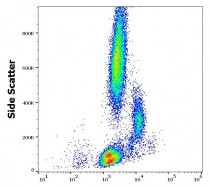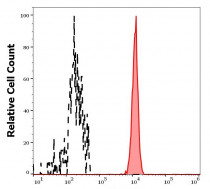ARG62957
anti-CD98 antibody [MEM-108] (FITC)
anti-CD98 antibody [MEM-108] (FITC) for Flow cytometry and Human
Developmental Biology antibody; Immune System antibody; Metabolism antibody; Signaling Transduction antibody
Overview
| Product Description | FITC-conjugated Mouse Monoclonal antibody [MEM-108] recognizes CD98 |
|---|---|
| Tested Reactivity | Hu |
| Tested Application | FACS |
| Specificity | The clone MEM-108 reacts with CD98, a 125 kDa disulfide-linked heterodimer (80 kDa glycosylated heavy chain + 45 kDa non-glykosylated light chain). CD98 is expressed on T lymphocytes (upon activation) and activated NK cells; it is also present at low levels on B lymphocytes, NK cells, monocytes and platelets. HLDA VI; WS Code BP 409 HLDA VI; WS Code NL N-L017 |
| Host | Mouse |
| Clonality | Monoclonal |
| Clone | MEM-108 |
| Isotype | IgG1 |
| Target Name | CD98 |
| Antigen Species | Human |
| Immunogen | RAJI human Burkitt's lymphoma cell line |
| Conjugation | FITC |
| Alternate Names | MDU1; 4T2HC; CD98; 4F2hc; 4F2 cell-surface antigen heavy chain; CD98HC; 4F2HC; NACAE; Solute carrier family 3 member 2; CD antigen CD98; 4F2 heavy chain antigen; Lymphocyte activation antigen 4F2 large subunit; 4F2 |
Application Instructions
| Application Suggestion |
|
||||
|---|---|---|---|---|---|
| Application Note | * The dilutions indicate recommended starting dilutions and the optimal dilutions or concentrations should be determined by the scientist. |
Properties
| Form | Liquid |
|---|---|
| Purification Note | The purified antibody is conjugated with Fluorescein isothiocyanate (FITC) under optimum conditions. The reagent is free of unconjugated FITC and adjusted for direct use. No reconstitution is necessary. |
| Buffer | PBS, 15 mM Sodium azide and 0.2% (w/v) high-grade protease free BSA |
| Preservative | 15 mM Sodium azide |
| Stabilizer | 0.2% (w/v) high-grade protease free BSA |
| Storage Instruction | Aliquot and store in the dark at 2-8°C. Keep protected from prolonged exposure to light. Avoid repeated freeze/thaw cycles. Suggest spin the vial prior to opening. The antibody solution should be gently mixed before use. |
| Note | For laboratory research only, not for drug, diagnostic or other use. |
Bioinformation
| Database Links |
Swiss-port # P08195 Human 4F2 cell-surface antigen heavy chain |
|---|---|
| Gene Symbol | SLC3A2 |
| Gene Full Name | solute carrier family 3 (amino acid transporter heavy chain), member 2 |
| Background | CD98 (4F2) is a type II transmembrane glycoprotein which serves as the heavy chain of the heterodimeric amino acid transporters (HATs). CD98, linked to various light chains by disulfide bond, is responsible for cell surface expression and basolateral localization of this transporter complex in polarized epithelial cells and also interacts with beta1 integrins and increases their affinity for ligand. Besides its roles in amino acid transport, CD98 is thus involved in cell fusion and activation. It is implicated in regulation of cellular differentiation, growth and apoptosis. |
| Function | Required for the function of light chain amino-acid transporters. Involved in sodium-independent, high-affinity transport of large neutral amino acids such as phenylalanine, tyrosine, leucine, arginine and tryptophan. Involved in guiding and targeting of LAT1 and LAT2 to the plasma membrane. When associated with SLC7A6 or SLC7A7 acts as an arginine/glutamine exchanger, following an antiport mechanism for amino acid transport, influencing arginine release in exchange for extracellular amino acids. Plays a role in nitric oxide synthesis in human umbilical vein endothelial cells (HUVECs) via transport of L-arginine. Required for normal and neoplastic cell growth. When associated with SLC7A5/LAT1, is also involved in the transport of L-DOPA across the blood-brain barrier, and that of thyroid hormones triiodothyronine (T3) and thyroxine (T4) across the cell membrane in tissues such as placenta. Involved in the uptake of methylmercury (MeHg) when administered as the L-cysteine or D,L-homocysteine complexes, and hence plays a role in metal ion homeostasis and toxicity. When associated with SLC7A5 or SLC7A8, involved in the cellular activity of small molecular weight nitrosothiols, via the stereoselective transport of L-nitrosocysteine (L-CNSO) across the transmembrane. Together with ICAM1, regulates the transport activity LAT2 in polarized intestinal cells, by generating and delivering intracellular signals. When associated with SLC7A5, plays an important role in transporting L-leucine from the circulating blood to the retina across the inner blood-retinal barrier. [UniProt] |
| Research Area | Developmental Biology antibody; Immune System antibody; Metabolism antibody; Signaling Transduction antibody |
| Calculated MW | 68 kDa |
| PTM | Phosphorylation on Ser-406; Ser-408 or Ser-410 and on Ser-527 or Ser-531 by ecto-protein kinases favors heterotypic cell-cell interactions. |
Images (2) Click the Picture to Zoom In
-
ARG62957 anti-CD98 antibody [MEM-108] (FITC) FACS image
Flow Cytometry: Human peripheral whole blood stained with ARG62957 anti-CD98 antibody [MEM-108] (FITC) (20 µl reagent / 100 µl of peripheral whole blood).
-
ARG62957 anti-CD98 antibody [MEM-108] (FITC) FACS image
Flow Cytometry: Separation of human monocytes (red-filled) from blood debris (black-dashed). Human peripheral whole blood stained with ARG62957 anti-CD98 antibody [MEM-108] (FITC) (20 µl reagent / 100 µl of peripheral whole blood).







